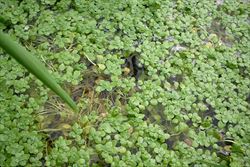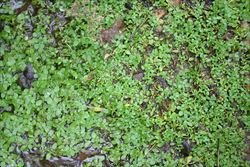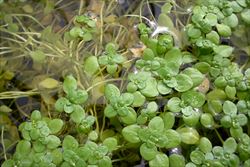Click on images to enlarge

infestation floating on water (Photo: Sheldon Navie)

infestation growing on muddy soil (Photo: Sheldon Navie)

floating habit (Photo: Sheldon Navie)

close-up of the leaves and male flowers, which consist of a single stamen (Photo: Greg Jordan)
Scientific Name
Callitriche stagnalis Scop.
Synonyms
Callitriche platycarpa Kuetzing
Family
Callitrichaceae
Common Names
common starwort, common water starwort, common water-starwort, mud water starwort, pond water starwort, pond water-starwort, starwort, water starwort
Origin
Native to Europe and northern Africa.
Naturalised Distribution
Widely naturalised in Australia, particularly in the southern parts of the country. It is widespread and common in southern and eastern New South Wales, in the ACT and Victoria, in Tasmania, in south-eastern South Australia and south-western Western Australia. Also occasionally naturalised in south-eastern and central Queensland, in western New South Wales, and in some inland parts of Western Australia.
Notes
Common water-starwort (Callitriche stagnalis) is regarded as an environmental weed in Western Australia and Victoria. This aquatic species was probably originally introduced as an aquarium plant, but is now a widespread weed of freshwater wetlands, slow-moving waterways, lakes, dams, drains and artificial water bodies in the temperate regions of Australia.
It is currently of most concern in Victoria, where it is seen as a potential threat to one or more indigenous vegetation formations, and is thought to be competing with several rare and threatened native plant species. For example, common water-starwort (Callitriche stagnalis) grows in moist habitats occupied by the ridged water-milfoil (Myriophyllum porcatum). This species is listed as threatened in Victoria, and its habitat is is thought to be endangered by the invasion of common water-starwort (Callitriche stagnalis ) and other weed species.
Common water-starwort (Callitriche stagnalis) is also very similar to several rare native water-starwort species (Callitriche spp.). Because these species also grow in similar moist habitats, they are often directly competing against the invasive common water-starwort (Callitriche stagnalis), and it is likely that the more robust and aggressive introduced species will out-compete the native species they grow together. The western water-starwort (Callitriche cyclocarpa) and the short water-starwort (Callitriche brachycarpa), two species that are listed as vulnerable in Victoria, are thought to be directly threatened by common water-starwort (Callitriche stagnalis).
Common water-starwort (Callitriche stagnalis) also inhabits riparian vegetation and wetter sites in temperate rainforests in Victoria, and has been recorded in several conservation areas in this state (e.g. the Brisbane Ranges National Park, Kinglake National Park, Morwell National Park and Yarra Bend Park). It also appears on several local and regional environmental weed lists (e.g. in Knox City, the Mornington Peninsula Shire and the Goulburn Broken Catchment).
This introduced species is also widespread in disturbed freshwater wetlands and other wet sites throughout south-western Western Australia and was recently listed as a moderately high priority species in this state's Environmental Weed Strategy. Though it does not appear much on environmental weed lists in other states, common water-starwort (Callitriche stagnalis) is just as common in many other parts of southern Australia. It has also been recorded in several conservation areas South Australia (e.g. Brownhill Creek Recreation Park, Deep Creek Conservation Park, Montacute Conservation Park, Scott Creek Conservation Park, Kyeema Conservation Park, Kaiserstuhl Native Forest Reserve and Charleston Conservation Park) and Tasmania (i.e. Strzelecki National Park and Tasman National Park in Tasmania).

